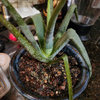ingredients of bonsai grittier mixture
Marie Tulin
13 years ago
More Discussions
Not having the ingredients for gritty mixture close by, I bought bonsai soil from a very reputable bonsai retailer. I asked its composition and it is
1/3turface
1/3 potting soil which is comprised of metro 5/10; pine bark fines and vermiculite
and
1/3 coarse sand (?) I actually didn't write down what product was coarse, but I'm guessing sand.
No other additives.
What do I need to add to it.
I'm using weak MG
I am repotting houseplants in it: begonias, amaryllis, and going to get to cyclamens.
I'm interested in your responses.
It was ridiculously expensive so I really want to make 1-1-1 "from scratch" If the plants do well, they'll just stay in the bonsai mix. I'll concentrate on getting the 5-1-1 mix for my outdoor pots.
Time to reread Al's advice on fertilizing.
Marie


jodik_gw
Marie TulinOriginal Author
Related Professionals
Wrentham Landscape Architects & Landscape Designers · East Chicago Landscape Contractors · Mesa Landscape Contractors · Salem Landscape Contractors · Brockton Solar Energy Systems · Mesquite Solar Energy Systems · Boise Window Contractors · St. Louis Window Contractors · Framingham Window Contractors · Sugarland Run Window Contractors · Ridgewood Fence Contractors · Hammond Fence Contractors · Laguna Hills Fence Contractors · Richmond Fence Contractors · West Sacramento Fence Contractorstapla (mid-Michigan, USDA z5b-6a)
jodik_gw